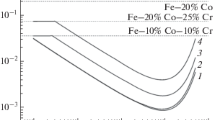Abstract
A thermodynamic analysis of the oxygen solutions in the titanium-containing Ni–Cr melts at 1873 K has been performed. The oxygen solubility in the Ni–Cr melts is shown to be higher than that in pure nickel. The higher the chromium content, the higher the oxygen solubility. Low titanium contents weakly affect the oxygen concentration in a melt, which is determined by the chromium content. At titanium contents of above 0.020–0.035%, titanium determines the oxygen solubility in a melt depending on the alloy composition. The titanium contents at the minima in oxygen solubility curves and the oxygen concentrations corresponding to the titanium contents have been determined.

Similar content being viewed by others
REFERENCES
V. Ya. Dashevskii, K. V. Grigorovich, P. V. Krasovskii, N. N. Makarova, and V. I. Kashin, “Thermodynamics of oxygen solutions in Ni–Cr melts,” Dokl. Akad. Nauk, 359 (2), 212–213 (1998).
V. Ya. Dashevskii, A. G. Kanevskii, N. N. Makarova, K. V. Grigorovich, and V. I. Kashin, “Deoxidation equilibrium of chromium in the liquid iron–nickel alloys,” ISIJ International 45 (12), 1783–1788 (2005).
N. P. Lyakishev and M. I. Gasik, Chromium Metallurgy (ELIZ, Moscow, 1999).
A. A. Aleksandrov, V. Ya. Dashevskii , and L. I. Leont’ev, “Thermodynamics of Oxygen Solutions in Nickel Melts Containing Aluminum and Titanium,” Steel Transl. 46 (7), 479–483 (2016).
L. N. Belyanchikov, “Universal method for recalculating interaction parameters of elements in changing the matrix of alloys using the quasi-regular solution theory. II. Estimating the interaction parameters of elements in nickel–based alloys,” Elecktrometallurgiya, No. 2, 29–38 (2009).
E. N. Kablov, I. L. Svetlov, and N. V. Petrushin, “Heat-resistant nickel alloys for cast blades with directional and single-crystal structure. Part 1,” Materialovedenie, No. 4, 32–39 (1997).
A. V. Logunov and Yu. A. Shmotin, Modern Heat-Resistant Nickel Alloys for Disc Gas Turbines (Nauka Tekhnologiya, Moscow, 2013).
Yu. V. Glagoleva, N. B. Pushkareva, Yu. E. Lapshova, et al., “Thermalphysic and kinetic properties of nickel–chromium alloys at high temperatures,” Phys. Met. Metallogr. 102 (1), 48–54 (2006).
S. N. Paderin and D. T. Sharipov, “Thermodynamic models and parameters of oxygen dissolved in liquid nickel,” Elektrometallurgiya, No. 12, 35–43 (2004).
N. P. Lyakishev and M. I. Gasik, Physicochemistry and Technology of Electro Ferroalloys (ELIZ, Moscow, 2005).
ACKNOWLEDGMENTS
This study was supported by the Russian Foundation for Basic Research, project no. 16-03-00641 A.
Author information
Authors and Affiliations
Corresponding authors
Additional information
Translated by N. Kolchugina
Rights and permissions
About this article
Cite this article
Aleksandrov, A.A., Dashevskii, V.Y. Thermodynamics of the Oxygen Solutions in the Titanium-Containing Ni–Cr Melts. Russ. Metall. 2018, 803–807 (2018). https://doi.org/10.1134/S0036029518090021
Received:
Published:
Issue Date:
DOI: https://doi.org/10.1134/S0036029518090021




